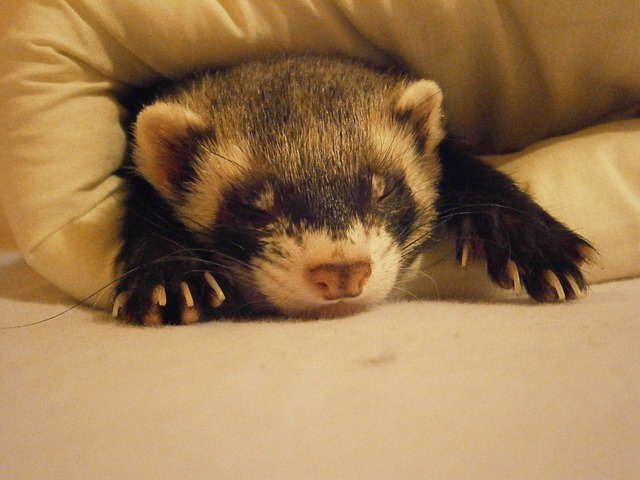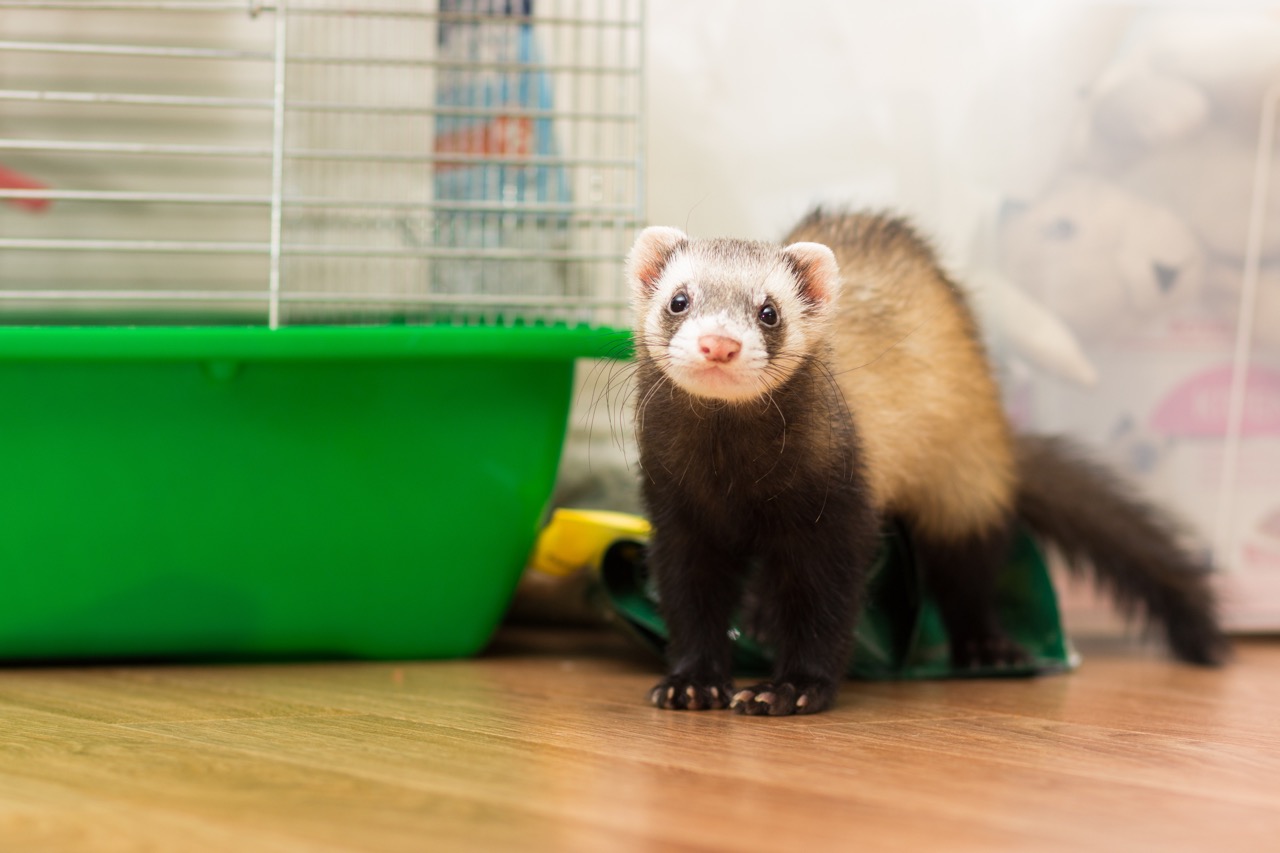
Did you know pet ferrets make wonderful companions? They are quiet, clean (if you know what you’re doing), affectionate animals who can be litter trained!
Ferret Guide promotes happy and healthy ferret ownership and provides tips on pet ferret care. You can learn how to create a safe, welcoming environment for your ferret and gain insight into ferret behavior, so you will better understand your ferret’s needs.
Get Started: New to Ferrets? | Ferret Care | Ferret Behavior | Ferret Health
Featured Pet Ferret Articles
-
All About Baby Ferrets
Baby ferrets are adorable, but there’s so much more to them than just looking cute! If you’re just curious about ferret babies, read on for plenty of fun facts. If you’ve found yourself as the new owner of a baby ferret, though, we’ve also got special care information you need to know! Read more >>
-
How Much Does a Pet Ferret Cost?
Many people may be misguided in thinking that ferrets are low-maintenance pets. The truth is that pet ferrets live at least 5 years, and they require a considerable amount of care, time, and money. Here is a basic rundown of how much a pet ferret can cost. Read more >>
-
Thinking About Getting a Pet Ferret?
Ferrets make wonderful pets for all types of owners. They are adorable and absolute brimming with personality! But before you turn to a pet store, breeder, or rescue to pick up a new best friend, there are a few things you should know to ensure a ferret is right for you and your family. Read more >>
Featured Ferret Cage
Your ferret spends quite a while in their cage eating, sleeping, and playing. So, it only makes sense that you need to provide a high quality living space! While you may be tempted to get your ferret the first cage that you happen to see, the reality is that all ferret cages are not created equal.
The Ferret Nation Deluxe Cage has all of the characteristics of the best ferret cage. The floor space available is well beyond the minimum required for ferrets to thrive, and the construction is solid and easy for ferrets to navigate. The provided ramp covers also make climbing and cleaning a breeze!
Intro to Ferrets
The ferret, or Mustela furo, is a small, domesticated form of the European polecat that is popular as a pet among a diverse demographic of over 5 million households. This is a relatively recent phenomenon, though, as ferrets were considered rare pets up until the mid-1980s.
There are numerous types/styles of ferrets, but they’re all the same species, meaning that all ferrets share many characteristics. The average length of a ferret is approximately 20 inches including their tail, and they weigh anywhere between 1.5 and 4.5 pounds. Being a sexually dimorphic species, male ferrets are significantly larger than females.
With proper care, which includes diet, housing, grooming, and playtime/socialization, ferrets typically live between 5-7 years, with some owners having noted lifespans that extended into their teens!
Some History
Let’s explore more of the history of the ferret and the reasons behind why these admittedly strange creatures were bred and domesticated in the first place. The reason behind humans domesticating ferrets isn’t certain, though.
Ferret DNA analyses have suggested that ferrets were first domesticated around 2,500 years ago, likely from the European polecat. While it’s been claimed that ancient Egyptians were the original domesticators of ferrets, there is little to no evidence to support this idea.
Again, it’s not known exactly why ferrets were domesticated, but it likely may have been for hunting purposes. Ferrets are long, lean, energetic, and inquisitive — all features that would facilitate entering burrows and chasing out rabbits, moles, and other animals. There are many examples dating back millennia of ferrets being used for population control.
In the year 1221, Genghis Khan was recorded using ferrets in a ploy to erase all wild animals from an entire region. In 1390 England, hunting with ferrets was fairly prominent, and a law was enacted to restrict the use of ferrets to only the wealthy.
The 1600s are where the Americas first got ferrets, and they were regularly used from the mid 1800s up to the beginning of World War II to keep rodents away from grain stores. To this day, ferrets are still used for hunting, but the practice is now illegal in several countries for the fear of creating an ecological imbalance.
Behavioral Characteristics
One of the ferrets’ most prominent characteristics is its sleep pattern. While many people think ferrets are nocturnal, they’re actually crepuscular, meaning that they’re most active around dawn and dusk. Outside of those hours, they prefer to sleep, often for around 14-18 hours per day.
Unlike polecats, ferrets are quite social, and most prefer living in groups of 2 or more. They’re also very energetic and curious when they’re awake, meaning that they need at least an hour a day to play (but 2+ is much better).
You may be familiar with the “weasel war dance”, which is a behavior exhibited by ferrets that essentially an invitation to play! It involves lateral hops, running forwards and backwards, and sporadically colliding with objects around them. There’s really nothing like it!
When it comes to eating, ferrets are a bit unique as well. Ferrets are obligate carnivores, meaning that they need to eat meat to survive. They also have extremely short digestive systems and fast metabolisms, which requires them to eat frequently. Because of this, high-protein ferret food needs to be provided at all times for them to eat frequently.
10 Interesting Facts
- Ferret is Latin for “Stinky Little Thief” — a name likely attributed thanks to a ferret’s tendency to steal and hide toys, clothes, and other small objects!
- All ferret babies are born without fur, and when their fur does start to come in, it’s always white. Only after about 3 weeks do their true colors start to come in.
- Ferrets are illegal in New York City, Hawaii, and DC, due to ecological and public safety concerns.
- A group of ferrets is called a business!
- Ferrets have four types of teeth, which are 12 incisors, 4 canines, 12 premolars, and 6 molars.
- In Hokkaido Japan, ferrets must be registered with the local government.
- Ferrets with a partially or fully-white head (not including albinos) almost certainly carry a congenital defect. Among some physical effects, this defect also causes partial or total deafness in an estimated 75% of ferrets with this coloration.
- Similar to skunks, ferrets can release anal grand secretions when scared. Fortunately, the smell is much less intense and doesn’t last long.
- Ferrets make a variety of different sounds, ranging from dooking (a happy “clucking” noise), hissing, and squeaking.
- Thanks to their many physiological and anatomical similarities with humans, ferrets are extensively used in biomedical research.
Health of the Ferret
Unfortunately, ferrets experience several health problems, with the most common being cancers of the adrenal glands, pancreas, and lymphatic systems.
Insulinoma – The most common form of cancer in ferrets that effects the islet cells of the pancreas.
Lymphoma – The most common malignancy in ferrets. There are two forms to this cancer — a fast-growing type present in young ferrets, and a slower-growing type effecting older ferrets.
Adrenal disease – Usually diagnosed by hair loss, aggression, and difficulty going to the bathroom, this disease is a growth of the adrenal glands, which is either cancer or hyperplasia. Treatment involves surgery, implants, and/or hormone therapy, and it’s thought to be caused by ultra-processed foods, irregular light cycles, and prepubescent neutering.
More commonly, ferrets can suffer from the occasional hairball and dental problems.
Misconceptions
Ferrets are, unfortunately, victims of quite a few misconceptions! Many of these are the result of bad/uneducated owners that practice improper care.
- Ferrets poop everywhere – This is true, if they’re not trained. Ferrets can be trained to use litter boxes with some patience and diligence.
- Ferrets can’t be trained – Aside from using the litter box, ferrets can be trained to follow some basic commands!
- Ferrets bite – Ferrets are actually not prone to biting. While they can bite, if they’re properly socialized and trained, it’s quite rare. However, ferrets do occasionally like to nip when playing (which can be addressed in training, too).
- Ferrets stink – If a ferret has its scent glands, isn’t neutered, isn’t fed a high-quality food, and their cage isn’t cleaned regularly, then they’re probably going to stink! However, if all of these factors are addressed, a ferret’s stink will be significantly reduced.
- Ferrets eat anything – To the contrary! Ferrets can’t eat much beyond meat as they are obligate carnivores. A high-quality ferret food, or raw meat if you’re fancy, and the occasional treat and salmon oil should be the extent of what a ferret eats.
- Ferrets don’t need vet care – Like any other animal, ferrets need regular screenings and additional vet care if necessary.
- Ferrets are difficult pets – While pet ferrets may have a bit of a learning curve, once you know what you’re doing, they’re quite easy to care for and extremely rewarding!
Featured Ferret Organization

Ferret Association of Connecticut, Hartford, CT
The Ferret Association of Connecticut is one of the oldest non-profit humane and educational ferret organizations in the United States. Founded in 1991, FACT maintains a shelter that works to find permanent homes for adoptable ferrets and provides lifetime care for special needs or older ferrets, publishes helpful information, and offers assistance to other ferret shelters and organizations.
Ferret rescues and shelters are shockingly sparse throughout the world, so providing support to those in existence is a great way to make a difference. Ferret Association of Connecticut is among the most impactful of these immensely important organizations.



